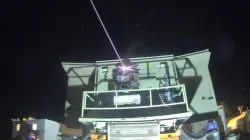Tel Aviv: Amid the ongoing war between Israel and other Middle Eastern nations, Israel's defence ministry has now announced to use of the most advanced version of Iron Dome, i.e. Iron Beam. Earlier on Monday, Israeli Defence Forces said it had already signed a 2 billion shekel ($ 536 million) deal with local contractors to expand production of a new laser-based missile defence system that could be operational in the next year.
The deal was signed with state-owned Rafael Advanced Defence Systems and Elbit Systems for a high-power laser called Iron Beam that is designed to counter aerial threats, including rockets, mortar bombs, drones and cruise missiles.
What is Iron Beam?
Iron beam is a laser technology system which will supplement the Iron Dome system, which shoots down rockets and missiles fired at Israel, using radar-guided missiles to blow up short-range threats. Eyal Zamir, the director general of Israel's defence ministry, said the Iron Beam deal "heralds the beginning of a new era in warfare." Iron Beam is seen by experts as a much cheaper alternative for neutralising enemy rockets and drones than the interceptor missiles Israel currently uses.
According to a report by CNN, Israel first unveiled a prototype of the Iron Beam in 2021 and has since been working to get it up and running.
How Iron Beam works
The system utilises a powerful ground-based laser. With a range spanning hundreds of meters to several kilometres, the laser targets and heats critical areas of a projectile's shell, such as its engine or warhead, until it fails, CNN reported.
This method differs from Israel’s conventional approach, which relies on radar to detect incoming threats and then launches interceptor missiles to neutralise them in mid-air.
READ: Israel developing 'Star Wars' laser missile shield named Iron Beam
Iron Beam'laser interception costs only $2
Each interception missile used by the Iron Dome is estimated to cost around $50,000 or more. According to Yehoshua Kalisky, a senior researcher at the Institute for National Security Studies (INSS) in Tel Aviv, Israel typically fires two missiles for each interception. Former Prime Minister Naftali Bennett had claimed each laser-based interception was expected to cost just $2, which he dubbed as nearly "negligible".
Will Iron Beam truly be a game-changer for Israel?
The Israeli Iron Beam has its limitations. Experts told CNN that the laser system struggles in cloudy, rainy, or hazy conditions, which impairs its ability to penetrate the atmosphere and hit its target. Additionally, the system demands a significant amount of power to function effectively.
Kalisky from the INSS told CNN that although the Iron Beam's potential as a "game-changer" for Israel remains uncertain, it will serve as an additional layer of defence. He noted that the system is expected to excel in countering drones and short-range rockets and missiles, but may not be as effective against ballistic missiles, which have typically been intercepted by Israel's Arrow 2 and Arrow 3 systems.
(With inputs from agency)
ALSO READ: Israel's Iron Dome: How layers of air defences protect country against biggest onslaught of rocket attacks
Latest World News
